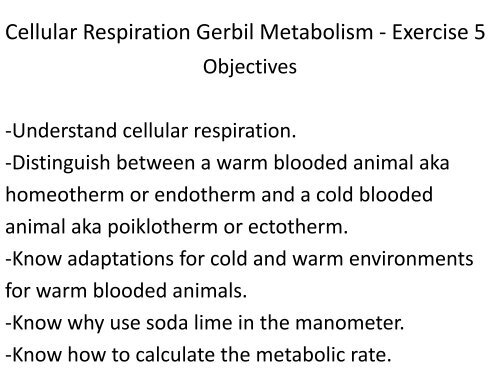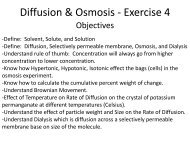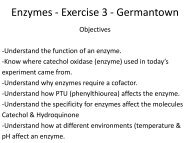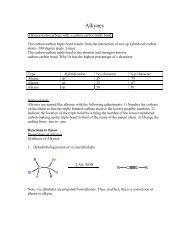Cellular Respiration Gerbil Metabolism - Science Learning Center
Cellular Respiration Gerbil Metabolism - Science Learning Center
Cellular Respiration Gerbil Metabolism - Science Learning Center
You also want an ePaper? Increase the reach of your titles
YUMPU automatically turns print PDFs into web optimized ePapers that Google loves.
<strong>Cellular</strong> <strong>Respiration</strong> <strong>Gerbil</strong> <strong>Metabolism</strong> - Exercise 5<br />
Objectives<br />
-Understand cellular respiration.<br />
-Distinguish between a warm blooded animal aka<br />
homeotherm or endotherm and a cold blooded<br />
animal aka poiklotherm or ectotherm.<br />
-Know adaptations for cold and warm environments<br />
for warm blooded animals.<br />
-Know why use soda lime in the manometer.<br />
-Know how to calculate the metabolic rate.
<strong>Cellular</strong> <strong>Respiration</strong><br />
• Harvesting energy for cellular processes<br />
– Complex organic molecules (glucose) rich in potential energy <br />
simpler waste products with the release of energy<br />
C 6 H 12 O 6 + 6O 2 6CO 2 + 6H 2 O + ENERGY (ATP+heat)<br />
• <strong>Respiration</strong> is a cumulative function of three metabolic stages<br />
• Glycolysis<br />
– Breaks down glucose into two molecules of pyruvate<br />
• The citric acid cycle<br />
– Completes the breakdown of glucose<br />
• Oxidative phosphorylation<br />
– Is driven by the electron transport chain<br />
– Generates ATP<br />
– Process occurs in the mitochondria ATP: adenosine<br />
triphosphate
Oxidation of Organic Fuel Molecules During<br />
<strong>Cellular</strong> <strong>Respiration</strong><br />
• During cellular respiration<br />
– Glucose is oxidized and oxygen is reduced<br />
• <strong>Cellular</strong> respiration<br />
– Oxidizes glucose in a series of steps<br />
Redox reactions: Transfer electrons from one reactant to another by oxidation and reduction<br />
In oxidation: A substance loses electrons, or is oxidized<br />
In reduction: A substance gains electrons, or is reduced<br />
becomes oxidized<br />
C 6 H 12 O 6 + 6O 2<br />
6CO 2 + 6H 2 O + Energy<br />
becomes reduced
The energy of glucose is used as food (or fuel) by nearly all living<br />
organism, including plants and animals, to stay alive, to main<br />
homeostasis, and to run their metabolism. The energy stored in<br />
chemical bonds of food molecules must be released and converted<br />
into a diffusible, usable form. That form is the high energy molecules<br />
ATP. The release of energy from organic food molecules is<br />
accomplished by the chemical process of oxidation. Oxidation is the<br />
release of electrons and energy from a substance. Glucose is usually<br />
the food molecule that is oxidized, and the oxidation process involves<br />
a great many separate steps or chemical reactions. These reactions<br />
are collectively called cellular respiration.<br />
If a molecular oxygen is available to the cell, the cell will generate<br />
proceed to oxidize the pyruvate aerobically (oxygen required) until it<br />
has been converted to carbon dioxide and water.
• In a container you have material that’s going to<br />
absorbed CO 2 in water. If we didn’t have that couldn’t<br />
do measurements. As gerbil breaths takes O 2 and gives<br />
off CO 2 . You wouldn’t see a change in volume of gases<br />
unless we get rid of CO 2 in the water.<br />
• All the reactions in all of the phases of cellular<br />
respiration result in some energy being lost in the form<br />
of heat – i.e., an increase in entropy.<br />
• In most organisms, heat is simply dispense into the<br />
surroundings environment, but some organisms have<br />
evolved mechanisms to keep heat and maintain a<br />
constant temperature.
• The heat is retained in part because of anatomical adaptations<br />
that reduce heat loss across the body surface. Some heat<br />
conserving adaptations include the evolution of fur, hair, feathers,<br />
and the deposition of fat near the body’s surface. These<br />
anatomical adaptations, along with a temperature detecting and<br />
regulation “thermostat” in the hypothalamus of the brain, enable<br />
certain animals to maintain a constant body temperature. Such<br />
animals are called homeotherm or endotherm these are birds,<br />
mammals, and the tuna fish species. All of the other animals are<br />
poiklotherms or ectotherm they are unable to maintain a constant<br />
internal body temperature. They cannot retain the heat that they<br />
produce, and their body temperature will fluctuate as the<br />
environmental temperature fluctuates.<br />
• Hemeothermic animals will regulate their product of heat<br />
(generate more when it is cold and less when it is hot) to maintain<br />
a constant body temperature despite fluctuations in the<br />
environmental temperature. Since the heat is produced from the<br />
chemical reactions of cellular respiration, the rate of cellular<br />
respiration is tried, in part, to thermoregulation (regulation of<br />
body temperature).
• Effect of Varying Temperature on the Rate of <strong>Metabolism</strong> of a Homeothermic<br />
animal<br />
• The process of cellular respiration produces ATP energy which is needed to run an<br />
organism metabolic process. So we can measure cellular respiration of an<br />
organisms, one is, in effect, also measuring the metabolic rate of that organisms.<br />
The metabolic rate can be determines by measuring either the rate of<br />
consumption of the raw materials (glucose or oxygen) of respiration, or by<br />
measuring the rate of production of the end products (CO 2 and water) or<br />
respiration. The easiest component to measure is oxygen consumption.<br />
• The animal is placed in a jar on a screen laying over a layer of soda lime. The soda<br />
lime will absorb carbon dioxide and water vapor; thus, they will not influence the<br />
gas pressure within the jar. The jar is sealed with a stopper connected to two ports.<br />
One leads to the outside air and the other port is connected to a pair of pipettes<br />
partially loaded with a colored fluid. The second pipette is open to the outside air.<br />
The fluid functions as manometer that will detect changes in pressure. The<br />
pressure on the fluid on the side of the open pipette will be constant (air pressure<br />
in the classroom does not change). The volume of oxygen consumed in any given<br />
time can be measured and extrapolated to an hourly rate.<br />
• The purpose of the laboratory experiment in today’s lab is to measure rate of<br />
cellular respiration (the metabolic rate) of gerbil at three different temperatures<br />
to see if there is a relationship between outside temperate and the metabolic<br />
rate of the gerbil.
Experimental procedure<br />
• The gerbil in the container and weigh and record<br />
the total weight of the two together. Subtract the<br />
weight of the container form the total to obtain the<br />
weight of the gerbil.<br />
• You will test the animals at 3 temperatures: cold<br />
(5 O ), room (23 O ), and warm (35 O ) or vice versa.
Calculation of Rate of <strong>Metabolism</strong><br />
• The rate of cellular respiration can be used as an<br />
indirect measure of the rate of over all metabolism<br />
since metabolism is dependent upon the ATP<br />
generated by cellular respiration.<br />
• In order to compare the metabolic rates of animals<br />
of difference sizes (weights), it is necessary to<br />
convert the hourly average per animals to the<br />
average per unit weight.
• The more energy gerbil consumes, the more oxygen he’s going to<br />
consume, the more CO 2 he’s going to make.<br />
• All reactions in cellular respiration result in some energy being lost<br />
in the form of heat, and disrupted though out the environment.<br />
Anatomical adaptations, these new innovations reduce heat loss<br />
across the body, for example, fur, hair, feathers, these things are<br />
use for insulation.<br />
• a) Homeotherm (Endotherm): Warm blooded such as humans,<br />
birds, mammals.<br />
• b) Polklotherm (Ectotherm): Unable to maintain constant<br />
internal body temperature. Body temperatures will fluctuate as<br />
the environmental temperature fluctuates.<br />
• The rate of CR (metabolic rate) can be determine by measuring<br />
either the rate of consumption of raw materials (glucose or<br />
oxygen) or production of end products CO 2 or water.
• Smaller organisms have a higher Surface area to<br />
body weight ratio.<br />
• A larger organism has a lower surface area volume<br />
to body weight ratio.<br />
• If you want to keep temperature fixed, at cold<br />
temperature your going to burn a lot of energy to<br />
stay warm. As temperature goes up, the energy<br />
goes down. If temperature gets really high, he’s<br />
going to lower his/her body temperature.
• During cellular respiration, the energy stored in the chemical<br />
bonds of food molecules is converted to the high energy<br />
molecules, ATP. Depending on the availability of oxygen,<br />
cellular respiration can take two paths. The anaerobic path<br />
(fermentation) does not require oxygen and yields little ATP.<br />
The aerobic path (citric acid cycle and electron transport<br />
chain) requires oxygen and yields much more ATP. Both paths<br />
start with glycolycis.<br />
• All of the reactions of cellular respiration also create heat.<br />
Aerobic cellular respiration in a homeotherm (gerbil).<br />
Homeotherms maintain a constant internal body temperature<br />
despite changes in the environment. One way that<br />
homeotherms maintain this constant temperature, is by<br />
adjusting their raters of cellular respiration - higher<br />
respiration rates create more heat. Because aerobic<br />
respiration requires oxygen, we will estimate aerobic<br />
respiration by measuring oxygen consumption.
Energy comes from two process<br />
• 1. Fermentation: Glucose is broken down into<br />
enthol and CO 2 . Process only generates 2 ATP’s<br />
form of energy.<br />
• 2. <strong>Cellular</strong> respiration process that generates 36<br />
ATP. Complete cellular oxidation of glucose<br />
molecules, requires oxygen.<br />
• Point: Trying to determine oxygen<br />
composition, then calculate the metabolic rate.
Glucose <strong>Metabolism</strong><br />
• <strong>Cellular</strong> respiration<br />
• C 6 H 12 O 6 + 60 2 + 36 or 38 ADP’s + 36 or 38 P → 6CO 2 + 6 H 2 O + 36 or 38 ATP’s<br />
• Glycolysis<br />
– Anaerobic cellular respiration<br />
• Transition step<br />
– Acetyl coenzyme A production<br />
• Krebs cycle<br />
– Energy transfer to coenzymes NAD + and FAD<br />
• Electron transport chain<br />
– ATP produced<br />
– Aerobic cellular respiration
Figure 23.26
Figure 23.25
• We need soda lime in the bottom that absorbs CO 2 ,<br />
and salts. Otherwise experiment wouldn’t work.
Page 73 – Lab Book<br />
Purpose<br />
• Measure CR of gerbil at three different temps and see relationship between<br />
outside temperature and metabolic rate of gerbil.<br />
• Difference of cage and gerbil in grams.<br />
• To compare metabolic rate of animals of different size (weigh) necessary<br />
to convert hourly average per animal temperature average per unit<br />
weight.
Page 6 – Lab Book
Page 74 – Lab Book
• The smaller the animal, the higher metabolic rate and<br />
vice versa.<br />
• Get metabolic rate and don’t forget units mlO 2 /hr/g<br />
O 2 consumption (ml) X 60 =<br />
Minutes<br />
mlO 2 /hr/g
Page 75 – Lab Book
Page 75 – Lab Book<br />
Which of these tables does not make sense with the rest<br />
of the data?
Page 75 – Lab Book<br />
The one on the third row because when it gets to the 35<br />
degrees Celsius its metabolic rate is increasing, and it<br />
should be decreasing.
Page 9 – Lab Book
Page 76 – Lab Book
Summary of <strong>Cellular</strong> <strong>Respiration</strong>
Questions<br />
1. What was the name of the instrument that we used in the cellular<br />
respiration lab?<br />
2. What did this instrument measure?<br />
3. During the experiment, the fluid moved (towards/away from) the<br />
gerbil because of changes in _________ pressure as the animal respired.<br />
4. An organism whose body temperature changes with the outside<br />
environment is called an _________ Its metabolic rate<br />
(increase/decreases) as temperature increases.<br />
5. An organism who is able to maintain a stable internal body<br />
temperature regardless of the environmental temperature is called an<br />
_________ It’s metabolic rate (increases/decreases) as temperature<br />
increases.
Questions<br />
1. What was the name of the instrument that we used in the cellular<br />
respiration lab? Manometer<br />
2. What did this instrument measure? Amount of oxygen consumed<br />
3. During the experiment, the fluid moved (towards/away from) the<br />
gerbil because of changes in gas or air pressure as the animal respired.<br />
4. An organism whose body temperature changes with the outside<br />
environment is called an ectotherm or poikilotherm Its metabolic rate<br />
(increase/decreases) as temperature increases.<br />
5. An organism who is able to maintain a stable internal body<br />
temperature regardless of the environmental temperature is called an<br />
endotherm or homeotherm It’s metabolic rate (increases/decreases) as<br />
temperature increases.
Questions<br />
6. Which of the following is homoeothermic?<br />
a. Fish<br />
b. Reptiles<br />
c. Grass hopper<br />
d. Chicken<br />
e. Paramecium<br />
7. In the experiment you did on cellular respiration, the soda lime in the gerbil’s jar:<br />
a. Provided oxygen for the gerbil.<br />
b. Absorbed oxygen given off by the gerbil<br />
c. Absorbed CO 2 given off by the gerbil.<br />
d. Provided CO 2 to the gerbil.<br />
e. Absorbed moister to keep the gerbil dry.
Questions<br />
6. Which of the following is homoeothermic?<br />
a. Fish<br />
b. Reptiles<br />
c. Grass hopper<br />
d. Chicken<br />
e. Paramecium<br />
7. In the experiment you did on cellular respiration, the soda lime in the gerbil’s jar:<br />
a. Provided oxygen for the gerbil.<br />
b. Absorbed oxygen given off by the gerbil<br />
c. Absorbed CO 2 given off by the gerbil.<br />
d. Provided CO 2 to the gerbil.<br />
e. Absorbed moister to keep the gerbil dry.
10.What is fermentation? What is the advantage of<br />
fermentation? What is the disadvantage of it?<br />
Questions<br />
8. In the experiment, you determined metabolic rate by<br />
measuring:<br />
a. Oxygen production by the gerbil<br />
b. The body temperature of the gerbil<br />
c. Oxygen consumption of the gerbil<br />
d. The rate at which the gerbil moved.<br />
9. What is the relationship between the body size and<br />
metabolic rate?
Questions<br />
8. In the experiment, you determined metabolic rate by<br />
measuring:<br />
a. Oxygen production by the gerbil<br />
b. The body temperature of the gerbil<br />
c. Oxygen consumption of the gerbil<br />
d. The rate at which the gerbil moved.<br />
9. What is the relationship between the body size and metabolic rate?<br />
The bigger you are, the slower your metabolic rate will be and vice versa.<br />
10. What is fermentation? What is the advantage of<br />
fermentation? What is the disadvantage of it? Ethanol + CO 2 are<br />
produced by fermentation & no oxygen is required.
Questions<br />
11.Calculate the metabolic rate of a gerbil that<br />
weights 120 g and consumes 4.2 ml of oxygen in 6<br />
minutes.<br />
12.Calculate the metabolic rate of a gerbil that<br />
weights 100 gm and consumes 2 ml of oxygen in 3<br />
minutes.<br />
13.A 50 gram gerbil who consumes 5 mL of oxygen in<br />
3 minutes would have a metabolic rate of?
Questions<br />
11. Calculate the metabolic rate of a gerbil that weights 120 g<br />
and consumes 4.2 ml of oxygen in 6 minutes.<br />
4.2/6 x 60 = 42 42/120 .35 ml/hr/g<br />
12. Calculate the metabolic rate of a gerbil that weights 100 gm<br />
and consumes 2 ml of oxygen in 3 minutes.<br />
2/3 x 60 = 40 40/100 .4 ml/hr/g<br />
13. A 50 gram gerbil who consumes 5 mL of oxygen in 3<br />
minutes would have a metabolic rate of?<br />
5/3 x 60 = 100 100/50 2 ml/hr/g







